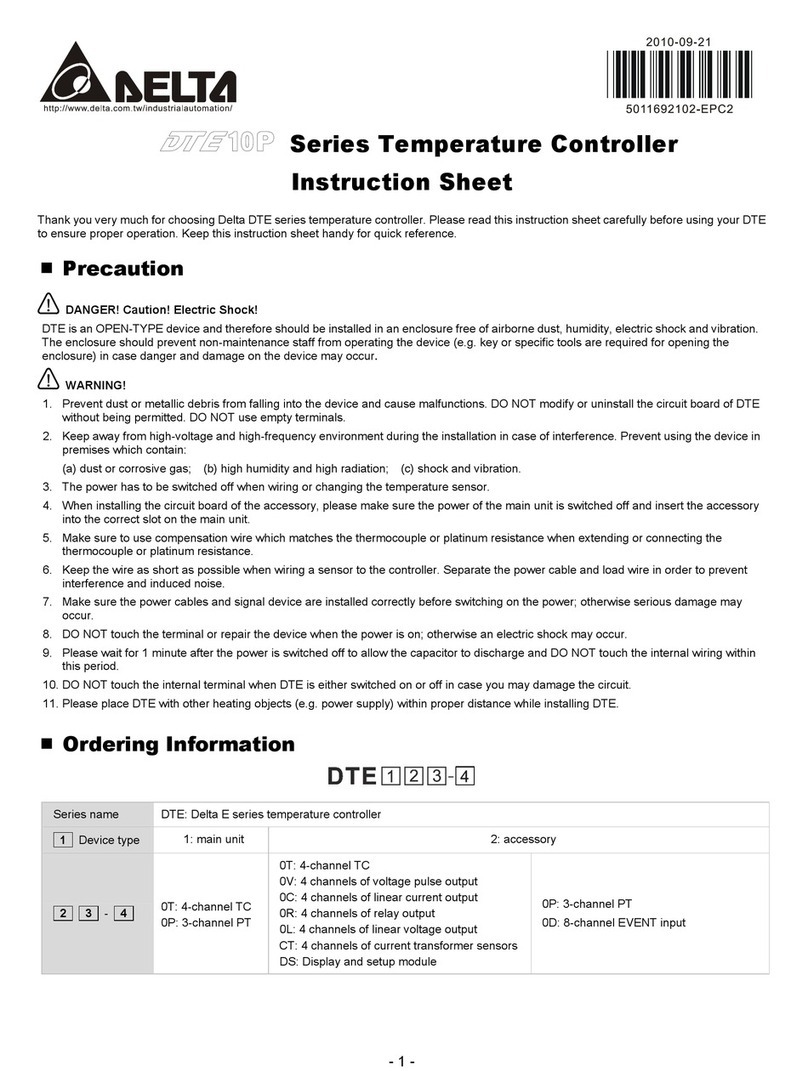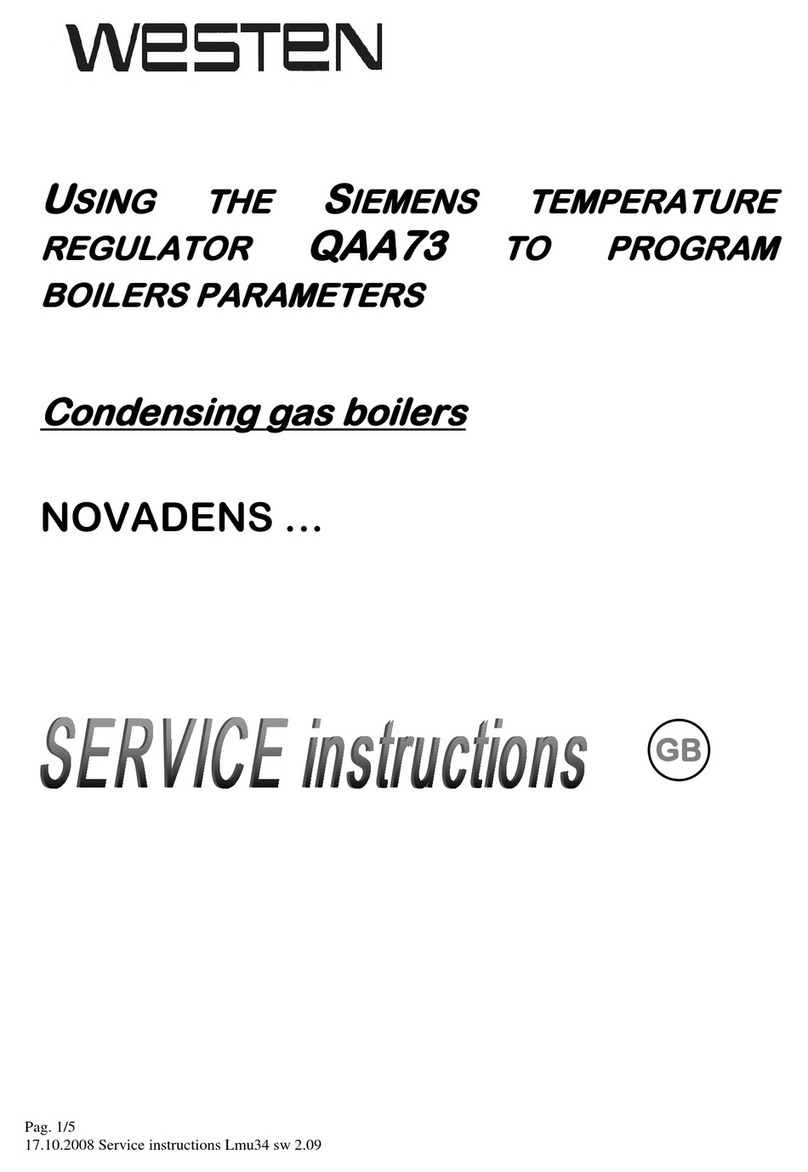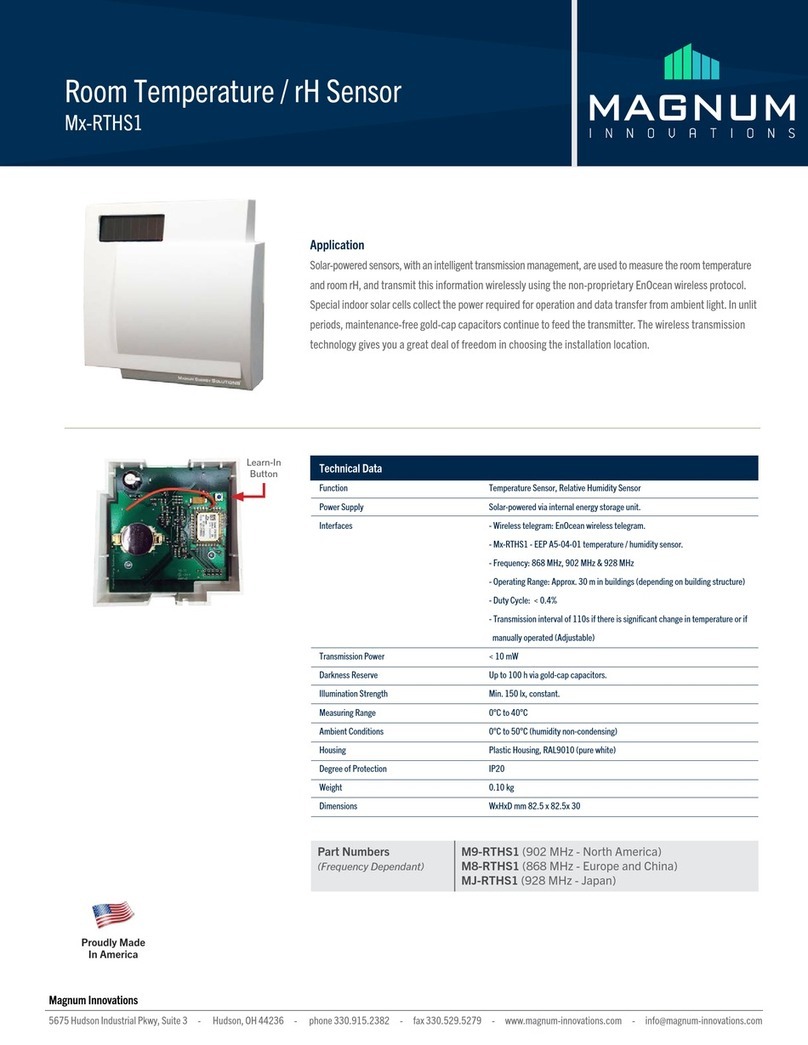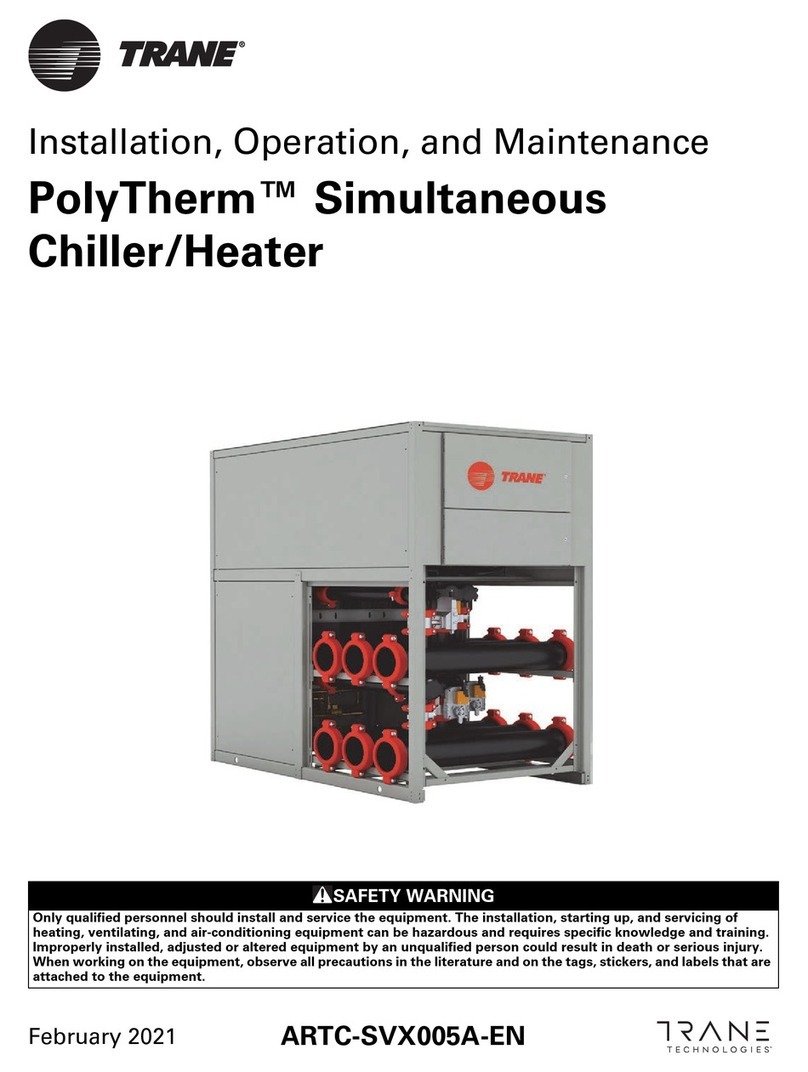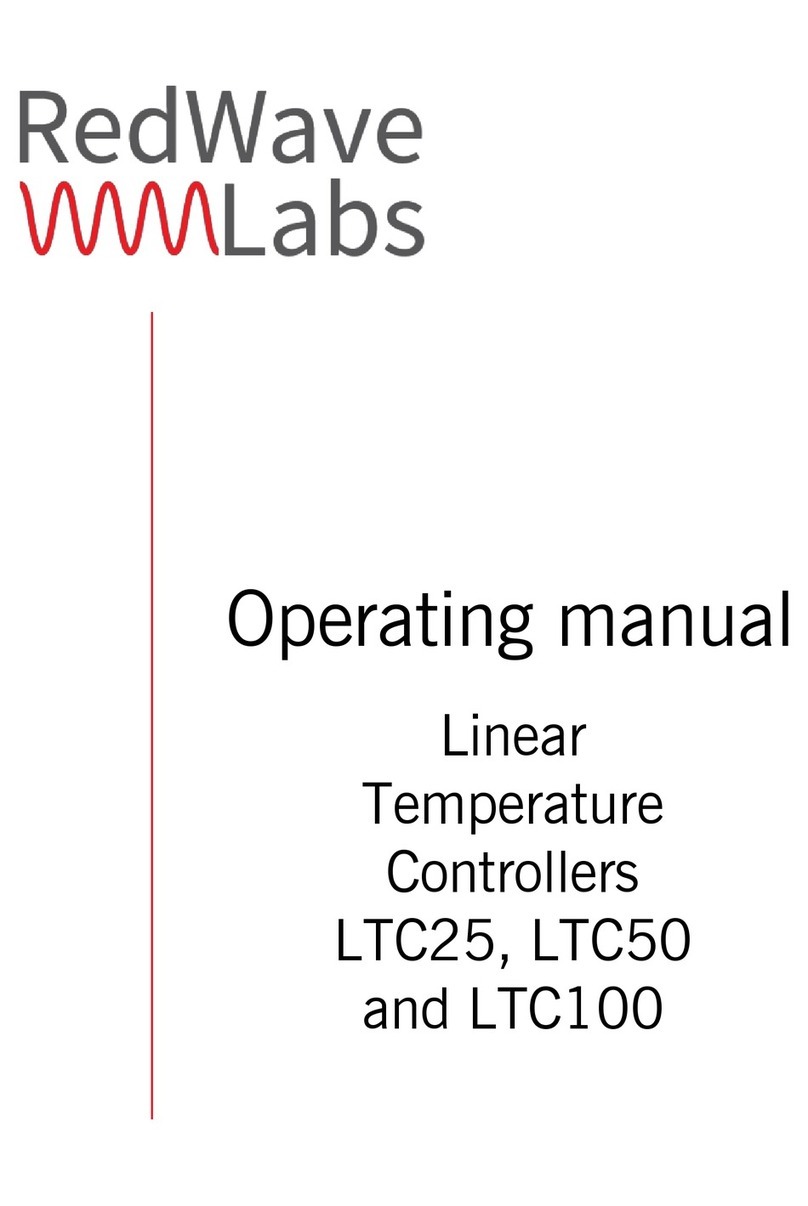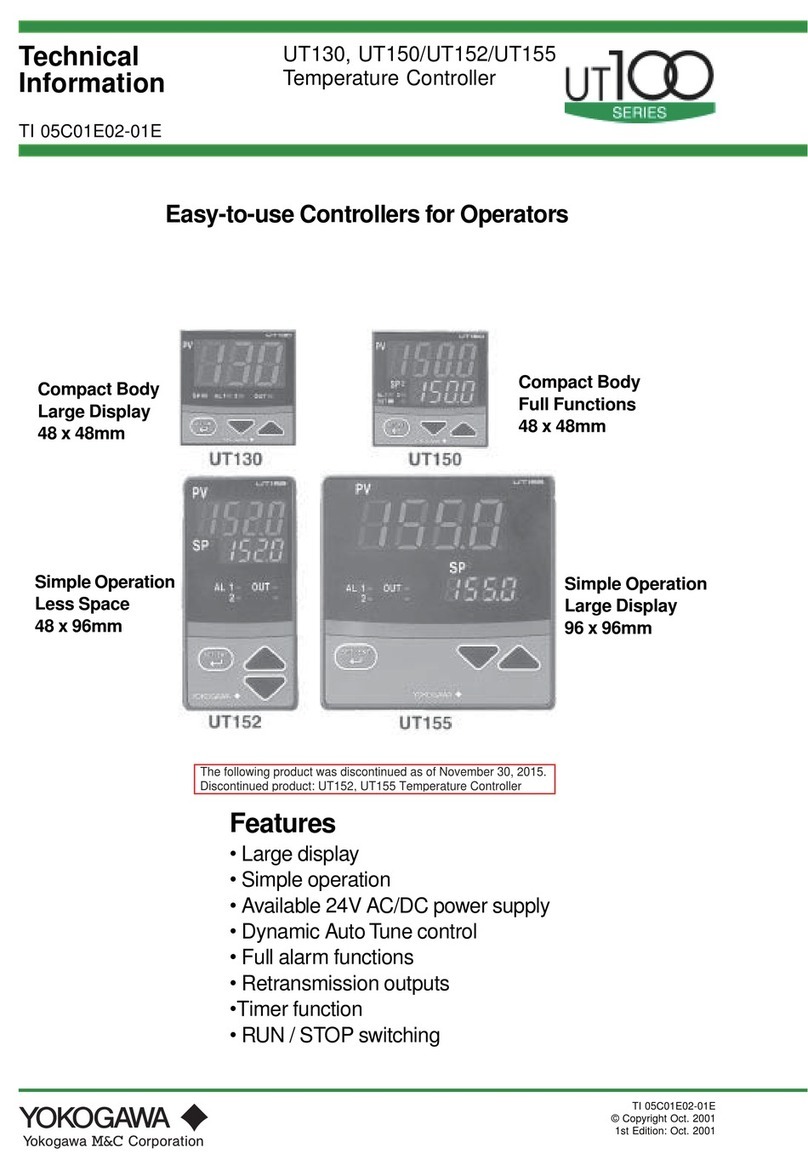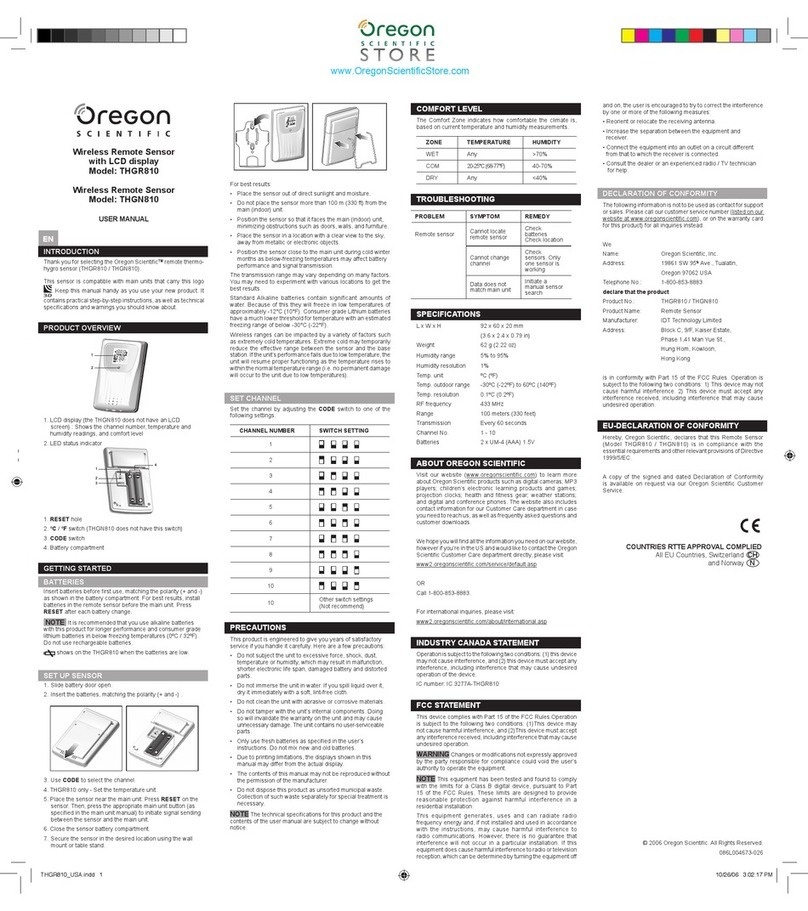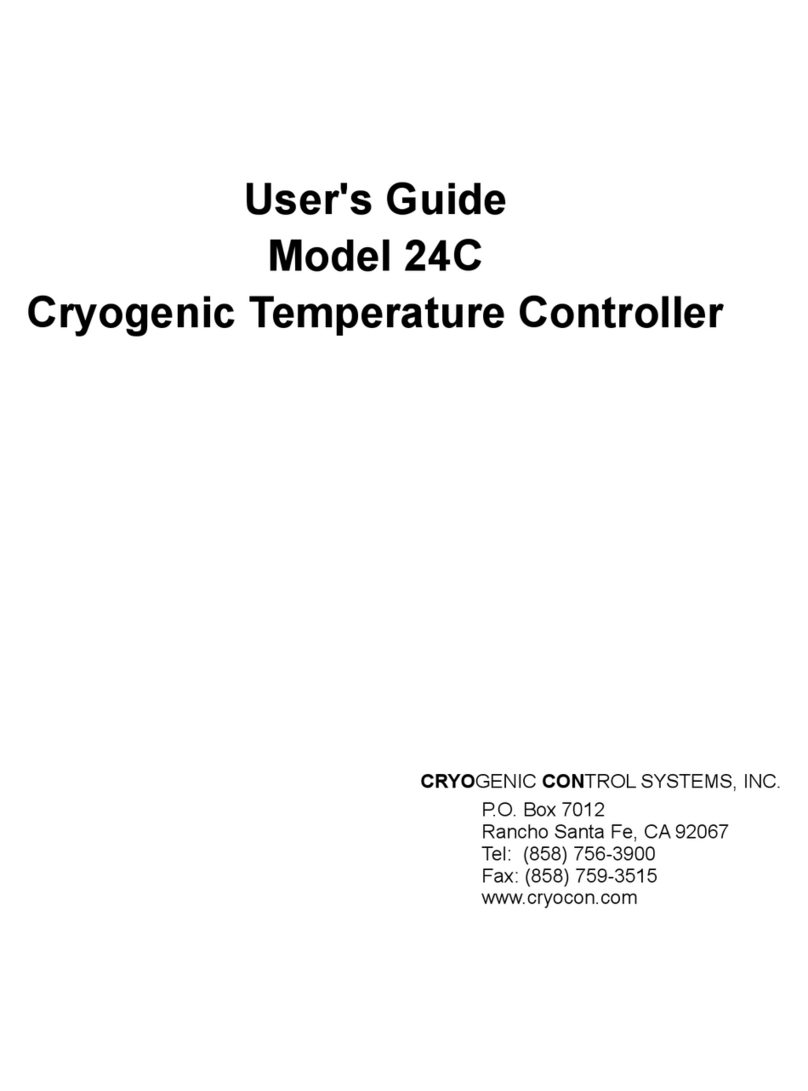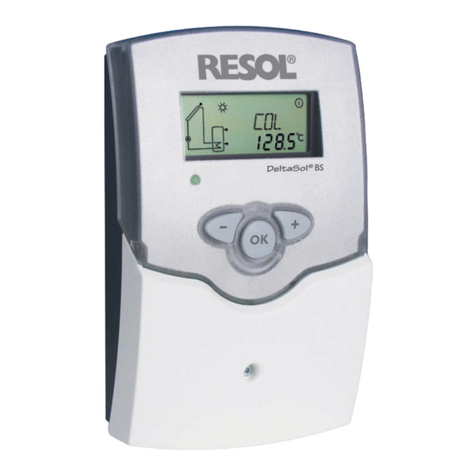Delta DTA4896R1 User manual

Http://www.delta.com.tw/industrialautomation
5011615707-DAE
7
2005-09-21
A Series Temperature Controller
Instruction Sheet
Thank you very much for purchasing DELTA A Series. Please read this instruction sheet
before using your A series to ensure proper operation and please keep this instruction
sheet handy for quick reference.
Precaution
DANGER! Caution! Electric Shock!
1. Do not touch the AC terminals while the power is supplied to the controller to
prevent an electric shock.
2. Make sure power is disconnected while checking the unit inside.
3. The symbol indicates that this Delta A Series Temperature Controller is
protected throughout by DOUBLE INSULATION or REINFORCED INSULATION
(equivalent to Class II of IEC 536).
WARNING!
This controller is an open-type temperature controller. Make sure to evaluate any
dangerous application in which a serious human injury or serious property damage
may occur.
1. Always use recommended solder-less terminals: Fork terminal with isolation (M3
screw, width is 7.0mm, hole diameter 3.2mm).
Screw size: M3 x 6.5 (With 6.8 x 6.8 square washer).
Recommended tightening torque: 0.4 N.m (4kgf.cm).
Applicable wire: Solid/twisted wire of 2 mm2, 12AWG to 24AWG.
Please be sure to tighten them properly.
2. Do not allow dust or foreign objects to fall inside the controller to prevent it from
malfunctioning.
3. Never modify or disassemble the controller.
4. Do not connect anything to the “No used” terminals.
5. Make sure all wires are connected to the correct polarity of terminals.
6. Do not install and/or use the controller in places subject to:
• Dust or corrosive gases and liquid.
• High humidity.
• High radiation.
• Vibration and shock.
• High voltage and high frequency
7. Must turn power off when wiring and changing a temperature sensor.
8. Be sure to use compensating wires that match the thermocouple types when
extending or connecting the thermocouple wires.
9. Please use wires with resistance when extending or connecting a platinum
resistance thermometer (RTD).
10. Please keep the wire as short as possible when wiring a platinum resistance
thermometer (RTD) to the controller and please route power wires as far as
possible from load wires to prevent interference and induced noise.
11. This controller is an open-type unit and must be placed in an enclosure away from
high temperature, humidity, dripping water, corrosive materials, airborne dust and
electric shock or vibration.
12. Please make sure power cables and signals from instruments are all installed
properly before energizing the controller, otherwise serious damage may occur.
13. Please do not touch the terminals in the controller or try to repair the controller
when power is applied to prevent an electric shock.
14. Wait at least one minute after power is disconnected to allow capacitors to
discharge, and please do not touch any internal circuit within this period.
15. Do not use acid or alkaline liquids for cleaning. Please use a soft, dry cloth to
clean the controller.
16. This instrument is not furnished with a power switch or fuse. Therefore, if a fuse or
power supply switch is required, install the protection close to the instrument.
Recommended fuse rating: Rated voltage 250 V, Rated current 1 A.
Fuse type: Time-lag fuse
Note: This controller does not provide overcurrent protection. Use of this product
requires that suitable overcurrent protection device(s) must be added to ensure
compliance with all relevant electrical standards and codes. (Rated 250 V, 15
Amps max). A suitable disconnecting device should be provided near the
controller in the end-use installation.
Display, LED and Pushbuttons
• PV Display : to display the process value or parameter type.
• SV Display : to display set point, parameter operation read value, manipulated
variable or set value of the parameter.
• AT : flashes when the Auto-tuning operation is ON.
• OUT : lights when the output is ON.
• : Function key. 1. Press this key to select the desired function mode.
2. Press this key to confirm a setting value.
• : Mode key. Press this key to set parameters within each function mode.
• oC, oF : Temperature unit LEDs. oC LED lights when this parameter is configured for
Celsius and oF LED lights if configured for Fahrenheit.
• ALM1 / ALM2 : Alarm output LED. The ALM1 / ALM2 LED lights when Alarm 1 or
Alarm 2 output is ON.
• : Up key. Press this key to increase values displayed on the SV display. Hold
down this key to speed up the incremental action.
• :Down key. Press this key to decrease values displayed on the SV display. Hold
down this key to speed up the decrements.
Specifications
Input Voltage 100 to 240VAC 50/60Hz
Operation Voltage Range 85% to 110% of rated voltage
Power Consumption 5VA max.
Display Method 7-segment digit LED Display
Process value (PV): Red color, Set point (SV): Green color
Thermocouple: K, J, T, E, N, R, S, B, U, L, Txk
Sensor Type 3-wire Platinum RTD: Pt100, JPt100
Control Mode PID, ON/OFF control or Manual tuning
Relay output:(resistive load): SPDT (SPST: 1/16 DIN size),
250VAC, 5A
Voltage Pulse output: DC 14V, Max. load current 40mA
Control Output
Current output: 4 to 20mADC (Load resistance: Max. 600Ω)
Display Accuracy 0.1% of measuring range
Sampling Rate 500 msec/per scan
Vibration Resistance 10 to 55Hz, 10m/s2for 10min, each in X, Y and Z directions
Shock Resistance Max. 300m/ s2, 3 times in each 3 axes, 6 directions
Ambient Temperature
0
o
C
to
+
50
o
C
Storage Temperature -
20
o
C
to
+
65
o
C
Relative Humidity 35% to 80% (non-condensing)
Altitude 2000m or less
Installation Environment Installation Category 33, Pollution Degree 2. Conforming to
EN61010-1
Parameters List
1. Operation Mode: Perform per the settings of related control parameters
LED Display Explanation Default
RUN/STOP: Control setting begins. Run ( ) or Stop
() mode on the SV display.
RUN
ALARM1 HIGH: Upper-limit alarm 1 4.0 oC
ALARM1 LOW: Lower-limit alarm 1 4.0 oC
ALARM2 HIGH: Upper-limit alarm 2 4.0 oC
ALARM2 LOW: Lower-limit alarm 2 4.0 oC
Setting lock: Lock 1 ( ), Lock 2 ( ) or OFF
() on the SV display. Lock 1 mode can lock all settings
and Lock 2 mode only can lock others than SV value. When
OFF mode is selected, the Lock function will be OFF. If you
press and key simultaneously, the “Lock” status can
be released and the controller will be back to the previous
display.
OFF
OUT: Output value display and output value adjustment in
manual tuning control (This function is not available in
ON/OFF control or Auto-tuning setting)
0
CT: In case of using an external current transformer (CT), the
controller displays the current value being measured by CT, if
the control output is ON
Read only
2. Regulation Mode: Set the control parameters
LED Display Explanation Default
AT: Auto-tuning setting. When AT key is set to ON ( ),
the execution of the PID auto-tuning function is automatically
started. (PID control)
OFF
P: Proportional Band (PID control) 47.6
I: Integral Time (PID control) 260
D: Derivative Time (PID control) 41
PdoF: Offset output when P or PD control function is ON. (PID
control and Ki=0) 0
ioF: Default value of integral volume when PID control function
is ON and integral time constant is not equal to 0(zero). AT
can automatically set this parameter. (PID control and Ki≠0)
0
HTS: Set Heating hysteresis when ON/OFF control function is
ON. 0
CTS: Set Cooling hysteresis when ON/OFF control function is
ON. 0
HTPD: PID heating control cycle setting (PID control)
CLPD: PID cooling control cycle setting (PID control)
Output
Selection:
V: 4 sec.
R: 20 sec.
TPOF: Regulate temperature deviation value 0
CRHI: Regulate 20mA output deviation value 0
CRLO: Regulate 4mA output deviation value 0
3. Initial Setting Mode: Initial settings of the controller and communication
parameters
LED Display Explanation Default
INPUT: Select input temperature sensor type
(Please refer to the contents of the “Temperature Sensor Type
and Temperature Range” for detail)
PT2
UNIT: Temperature display unit, oC( ) and oF( )
oC
T-HIGH: Upper limit for temperature range 500.0
T-LOW: Lower limit for temperature range -20.0
CONTROL: Control method setting on the SV display: PID
(), ON/OFF control ( ), or manual tuning
()
PID
SWITCH: Select Heating ( ) or Cooling ( )
action HEAT
AL1 SET: Alarm 1 setting 0
AL2 SET: Alarm 2 setting 0
C WE: Write-in function disable/enable
(Displayed when using serial communication) OFF
C NO: Address setting
(Displayed when using serial communication) 1
BPS: Baud rate setting
(Displayed when using serial communication) 9600
LENGTH: Data length setting
(Displayed when using serial communication) 7
PARITY: Parity bit setting
(Displayed when using serial communication) E
STOP BIT: Stop bit setting
(Displayed when using serial communication) 1
Note: Alarm values should be set in the initial setting mode so AL1H, AL1L, AL2H
and AL2L would display in operation mode.
Heating and Cooling Control
Temperature control is achieved either by heating or by cooling. The heating function
starts when the process temperature (PV) is going down, and the cooling function when
the temperature is getting high. It is impossible to operate both functions simultaneously
in this controller.
Temperature Sensor Type and Temperature Range
Input Temperature Sensor Type Register
Value
LED
Display
Temperature
Range
Platinum resistance (Pt100) type3 15
0.0 to 100.0 oC
Platinum resistance (Pt100) type2 14
-20.0 to 500.0 oC
Platinum resistance (Pt100) type1 13
-200 to 600 oC
Platinum resistance (JPt100) type2 12
0.0 to 100.0 oC
Platinum resistance (JPt100) type1 11
-20.0 to 400.0 oC
Thermocouple (TC) B type 10
100 to 1800 oC
Thermocouple (TC) S type 9
0 to 1700 oC
Thermocouple (TC) R type 8
0 to 1700 oC
Thermocouple (TC) N type 7
-200 to 1300 oC
Thermocouple (TC) E type 6
0 to 600 oC
Thermocouple (TC) T type2 5
-20.0 to 400.0 oC
Thermocouple (TC) T type1 4
-200 to 400 oC
Thermocouple (TC) J type2 3
-20.0 to 400.0 oC
Thermocouple (TC) J type1 2
-100 to 850 oC
Thermocouple (TC) K type2 1
-20.0 to 500.0 oC
Thermocouple (TC) K type1 0
-200 to 1300 oC
Thermocouple (TC) L type 16
-200 to 850 oC
Thermocouple (TC) U type 17
-200 to 500 oC
Thermocouple (TC) Txk type 18
-200 to 800 oC
Input Error Indication
Setting
value
Temperature sensor is
not connected
Measured temperature value
exceeds the temperature range Unknown input
PV
SV
Operation
There are three modes of operation: operation, regulation and initial setting. When power
is applied, controller gets into the operation mode. Press the key to switch to
regulation mode. If the key is pressed for more than 3 seconds, controller will switch
to the initial setting mode. Pressing the key while in the regulation mode or initial
setting mode, forces the controller to return to the operation mode.
PV/SV: Sets the temperature set point and displays the temperature process value. Use
the and keys to set the temperature set point.
Setting method: While in any function mode, press the key to select the desired
function and use the and keys to change settings. Press key to save the
changes.
The next flow chart shows how to switch for settings and internal functions:
Regulation
Mode
Operation
Mode
Initial Setting
Mode
Press key less than 3 sec
Press key Press key
Press key more than 3 sec
Regulation
Mode
Operation
Mode
Initial Setting
Mode
Press
Auto-tuning
(In PID control and RUN mode)
Set PID PB
(In PID control)
Set PID Ti
(In PID control)
Set PID Td
(In PID control)
P/PD control Offset setting
(When PID control is ON and Ki 0,
set the value of PdoF; If Ki 0, AT
will automatically set the value of
ioF
=
≠
Heating/Cooling hysteresis
(In ON/OFF control)
or
(In PID control)
Set Heating/Cooling
control cycle
or
or
Regulate temperature
deviation value
Regulate 20mA output
deviation value
(Display when current output)
Return to auto-tuning setting
Regulate 4mA output
deviation value
(Display when current output)
Press
Press
Press
Press
Press
Press
Press
Press
Press
Control setting
RUN or STOP
Upper-limit alarm 1
Use
set temperature of target
Lower-limit alarm 1
(This parameter is available only
when ALA1 function enables)
Upper-limit alarm 2
Lower-limit alarm 2
Setting lock mode
Return to temperature display
(This parameter is available only
when ALA1 function enables)
(This parameter is available only
when ALA2 function enables)
(This parameter is available only
when ALA2 function enables)
to
Output value display
and adjust
Press
Press
Press
Press
Press
Press
Press
Press
Press
CT function is selected
In case of using an external CT,
the controller displays the current
value being measured by CT, if
the control output is ON.
Set input type
Set temperature unit
Set upper-limit of
temperature range
Set lower-limit of
temperature range
Select control method
Select heating/cooling
functions
Alarm 1 setting
Alarm 2 setting
Write-in function
disable/enable
(Displayed when using serial
communication)
Baud rate setting
Data length setting
Parity bit setting
Address setting
Press
Press
Press
Press
Press
Press
Press
Press
Press
Press
Press
Press
Press
(Displayed when using serial
communication)
(Displayed when using serial
communication)
(Displayed when using serial
communication)
(Displayed when using serial
communication)
Stop bi t setting
Return to input type setting
Press
(Displayed when using serial
communication)

Ordering Information
DT
A
Series DTA : Delta A Series Temperature Controller
Panel Size
(W ×H)
4848 : 1/16 DIN W48 ×H48mm 9648: 1/8 DIN W96 x H48
4896 : 1/8 DIN W48 ×H96mm 7272 : W72 ×H72mm
9696 : 1/4 DIN W96 ×H96mm
Output Selection
R : Relay output, SPDT (SPST: 1/16 DIN size), 250VAC, 5A
V : Voltage Pulse output, 14V+10% ~ -20%(Max. 40mA)
C : Current output, 4~20mA
Communication
(
O
p
tional
)
0 : No interface
1 : RS-485
Current Transformer
(CT) Function
(Optional)
None : No CT function (Current transformer is not provided)
T : Current transformer is provided (only DTA7272 series
support this function)
Current Transformer (CT) Function
The Current Transformer (CT) function is used with the alarm output. When using a
current transformer (CT) with the controller, change the corresponding alarm output
mode to mode 13 (alarm output set value is 13), then turn to operation mode and set the
current lower-limit and current upper-limit. You can set current alarm range between 0.5A
~ 30A, display resolution is 0.1A and measure accuracy is +/- 0.5A.
Communication Parameters List
Controller offers a RS-485 port for serial communication.
• Supporting transmission speed: 2400, 4800, 9600, 19200, 38400bps
• Communication protocol: Modbus (ASCII)
• Non-supported formats: 7, N, 1 or 8, O, 2 or 8, E, 2
• Available communication address: 1 to 255, 0 is broadcast address
• Function code: 03H to read the contents of register (Max. 3 words).
06H to write 1 (one) word into register.
Address Content Explanation
4700H (R) Process value (PV) Measuring unit is 0.1, updated one
time in 0.5 second
4701H Set point (SV) Unit is 0.1, oCor oF
4702H Upper-limit alarm 1
4703H Lower-limit alarm 1
4704H Upper-limit alarm 2
4705H Lower-limit alarm 2
4706H Upper-limit of temperature range The data content should not be
higher than the temperature range
4707H Lower-limit of temperature range The data content should not be
lower than the temperature range
4708H PB Proportional band 0.1 to 999.9, unit is 0.1
4709H Ti Integral time 0 to 9999
470AH Td Derivative time 0 to 9999
470BH Heating/Cooling hysteresis 0 to 9999
470CH~ 470FH Reserved
4710H Input temperature sensor type
Please refer to the contents of the
“Temperature Sensor Type and
Temperature Range” for detail
4711H Control method 0: PID (default), 1: ON/OFF,
2: manual tuning
4712H Heating/Cooling control cycle 1 to 99 second
4713H Proportional control offset error
value 0% to 100%
4714H Temperature regulation value -999~999, unit: 0.1
4715H Alarm 1 type Please refer to the contents of the
“Alarm Outputs” for detail
4716H Alarm 2 type Please refer to the contents of the
“Alarm Outputs” for detail
4717H Temperature unit display selection oC: 1 (default), oF: 0
4718H Heating/Cooling control Selection Heating: 0 (default), Cooling: 1
4719H Control Run/Stop setting Run: 1 (default), Stop:0
471AH Communication write-in selection
Communication write in disabled: 0
(default), Communication write in
enabled: 1
471BH Software version V1.00 indicates 0 x 100
4729H AT Setting OFF: 0 (default), ON:1
Code 0 Normal operation (No error)
Code 1 Initial process
Code 2 Initial status (Temperature is not
stable)
Code 3 Temperature sensor is not
connected
Code 4 Temperature sensor input error
Code 5 Measured temperature value
exceeds the temperature range
Code 6 No Int. error
472BH (R)
Code 7 EEPROM Error
4733H CT monitor value Unit is 0.1A
Note: R means “read only” value
Alarm Outputs
There are up to two groups of alarm outputs and each group allows ten alarm types in
the initial setting mode. The alarm output is activated whenever the process temperature
value (PV) is getting higher or lower than the set point of alarm limit.
Set
Value Alarm Type Alarm Output Operation
0 Alarm function disabled Output OFF
1
Deviation upper- and lower-limit:
This alarm output operates when PV value is
higher than the setting value SV+(AL-H) or lower
than the setting value SV-(AL-L).
ON
OFF
SV-(AL-L) SV SV+(AL-H)
2
Deviation upper-limit:
This alarm output operates when PV value is
higher than the setting value SV+(AL-H).
ON
OFF
SV SV+(AL-H)
3
Deviation lower-limit:
This alarm output operates when PV value is
lower than the setting value SV-(AL-L).
ON
OFF
SV
SV-(AL-L)
4
Reverse deviation upper- and lower-limit:
This alarm output operates when PV value is in
the range of the setting value SV+(AL-H) and SV-
(AL-L).
ON
OFF
SV
SV-(AL-L) SV+(AL-H)
5
Absolute value upper- and lower-limit:
This alarm output operates when PV value is
higher than the setting value AL-H or lower than
setting value AL-L.
ON
OFF
AL-L AL-H
6
Absolute value upper-limit:
This alarm output operates when PV value is
higher than the setting value AL-H.
ON
OFF
AL-H
7
Absolute value lower-limit:
This alarm output operates when PV value is
lower than the setting value AL-L.
ON
OFF
AL-L
8
Deviation upper- and lower-limit with standby
sequence:
This alarm output operates when PV value
reaches set value (SV value) and the value is
higher than the setting value SV+(AL-H) or lower
than the setting value SV-(AL-L).
ON
OFF
SV
SV-(AL-L) SV+(AL-H)
9
Deviation upper-limit with standby sequence:
This alarm output operates when PV value
reaches set value (SV value) and the reached
value is higher than the setting value SV+(AL-H).
SV+(AL-H)
ON
OFF
SV
10
Deviation lower-limit with standby sequence:
This alarm output operates when PV value
reaches the set value (SV value) and the reached
value is lower than the setting value SV-(AL-L).
SV-(AL-L)
ON
OFF
SV
11
Hysteresis upper limit alarm output: this alarm
output operates if PV value is higher than the
setting value SV+(AL-H). This alarm output is
OFF when PV value is lower than the setting
value SV+(AL-L).
ON
OFF
AL-L
SV AL-H
12
Hysteresis lower limit alarm output: this alarm
output operates if PV value is lower than the
setting value SV-(AL-H). This alarm output is
OFF when PV value is higher than the setting
value SV-(AL-L).
ON
OFF
AL-H AL-L SV
13
CT alarm output:
This alarm operates when the current measured
by transformer (CT) is lower than AL-L or higher
than AL-H (This alarm output is available only for
the controller with current transformer).
ON
OFF
AL-L SV AL-H
Note: AL-H and AL-L include AL1H, AL2H and AL1L, AL2L.
With standby sequence: It means that the alarm output would be temporarily disabled
until the PV value reaches the set value. Then, the alarm output will operate.
Communication Protocol
Command code to read N words: 03H. The maximum value of N is 3.
For example, in order to read two words from controller 01 (address 01H) at starting data
address 4700H, the command in ASCII mode is:
ASCII mode:
Command message: Response message:
STX ‘:’ STX ‘:’
‘0’ ‘0’ADR1
ADR0 ‘1’
ADR1
ADR0 ‘1’
‘0’ ‘0’CMD1
CMD0 ‘3’
CMD1
CMD0 ‘3’
‘4’ ‘0’
‘7’
Number of data
(count by byte) ‘4’
‘0’ ‘0’
Starting data address
‘0’ ‘1’
‘0’ ‘9’
‘0’
Content of start address
4700H
‘0’
‘0’ ‘0’
Number of data (count
by word)
‘2’ ‘0’
‘B’ ‘0’LRC CHK 1
LRC CHK 0 ‘3’
Content of start address
4701H
‘0’
CR ‘6’END 1
END 0 LF
LRC CHK 1
LRC CHK 0 ‘7’
CR
END 1
END 0 LF
LRC check:
LRC check is the added sum from “Address” to “Data content”. For example, 01H + 03H + 47H
+ 00H + 00H + 02H = 4DH, then take the complementary of 2, B3H.
Command code to write 1 word: 06H
For example, in order to write 1000 (03E8H) in controller 01 (comm. address 01H) at the
starting data address 4701H, the command in ASCII mode is:
ASCII mode:
Command message: Response message:
STX ‘:’ STX ‘:’
‘0’ ‘0’ADR1
ADR0 ‘1’
ADR1
ADR0 ‘1’
‘0’ ‘0’CMD1
CMD0 ‘6’
CMD1
CMD0 ‘6’
‘4’ ‘4’
‘7’ ‘7’
‘0’ ‘0’
Starting data address
‘1’
Starting data address
‘1’
‘0’ ‘0’
‘3’ ‘3’
Data content
‘E’
Data content
‘E’
‘8’ ‘8’
‘C’ ‘C’LRC CHK 1
LRC CHK 0 ‘6’
LRC CHK 1
LRC CHK 0 ‘6’
CR CREND 1
END 0 LF
END 1
END 0 LF
Panel Cutout & External Dimensions
1. Panel wall thickness should range from 1mm to 8mm
2. Provide at least 90 mm clearance around the controller for proper ventilation.
(Dimensions are in millimeter and (inch))
DTA 4848
DTA 4896
DTA9648
DTA7272
DTA9696
Terminals Identification
DTA4848
1
2
5
6
8
7
4
3
9
12
13
14
15
11
10
DC 4~20mA
5A 250Vac
RTD
Tc
14Vdc
-
+
+
-
or
DATA-
DATA+
RS-485
COM
ALM2
ALM1 3A 250Vac
AC 100~240V
50~60Hz /5VA
L
N
DTA4896/DTA9648/DTA9696
1
2
5
6
8
7
4
3
9
12
13
14
15
11
10
5A 250Vac
RTD
Tc
+
-
or
DATA-
DATA+
RS-485
ALM1
ALM2
3A 250Vac
3A 250Vac
16
18
17
19
20
AC 100~240V
50~60Hz /5VA
DC 4~20mA
COM
COM
14Vdc
NC
NO
COM +
-
L
N
DTA7272
1
2
5
6
8
7
4
3
10
11
12
13
9
RTD
Tc
+
-
or
DATA-
DATA+
RS-485
COM
ALM1
ALM2 3A 250Vac
14
16
15
AC 100~240V
50~60Hz /5VA
5A 250Vac
NC
NO
COM
L
N
CT
OUTPUT
Mounting
Step-1. Insert the controller through the panel cutout.
Step-2. Insert the mounting bracket into the mounting groove at the top and bottom of
the controller and push the mounting bracket forward until the bracket stops at
panel wall.
Step-3. Insert and tighten screws on bracket to secure the controller in place.
(The screw torque should be 0.8kgf-cm to 1.5kgf-cm)
1
3
2
Mounting Bracket Installation
1. 2.
CT Wiring Method (if CT function is selected)
06.8mmMax.
This manual suits for next models
5
Table of contents
Other Delta Temperature Controllers manuals
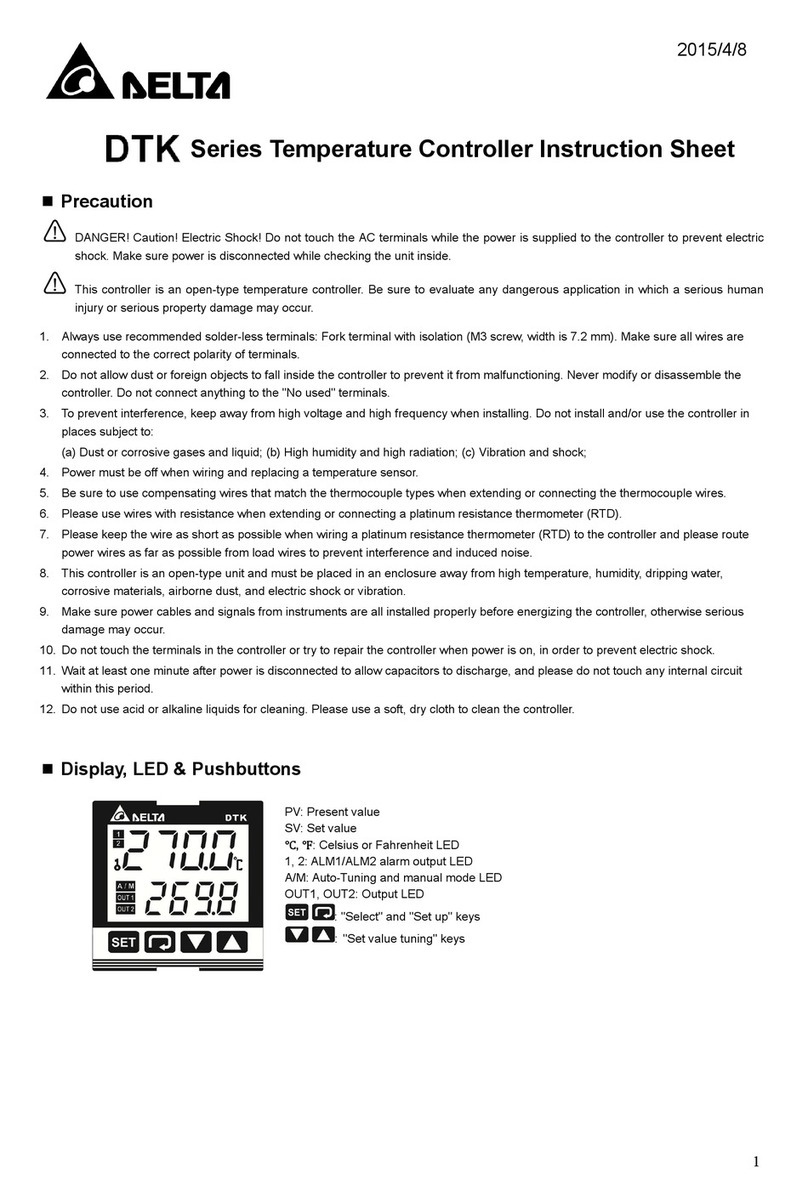
Delta
Delta DTK Series User manual
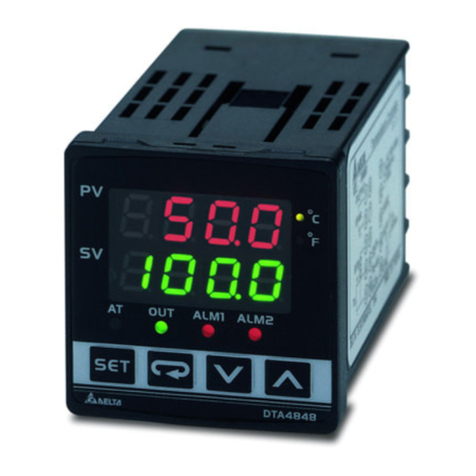
Delta
Delta A Series User manual
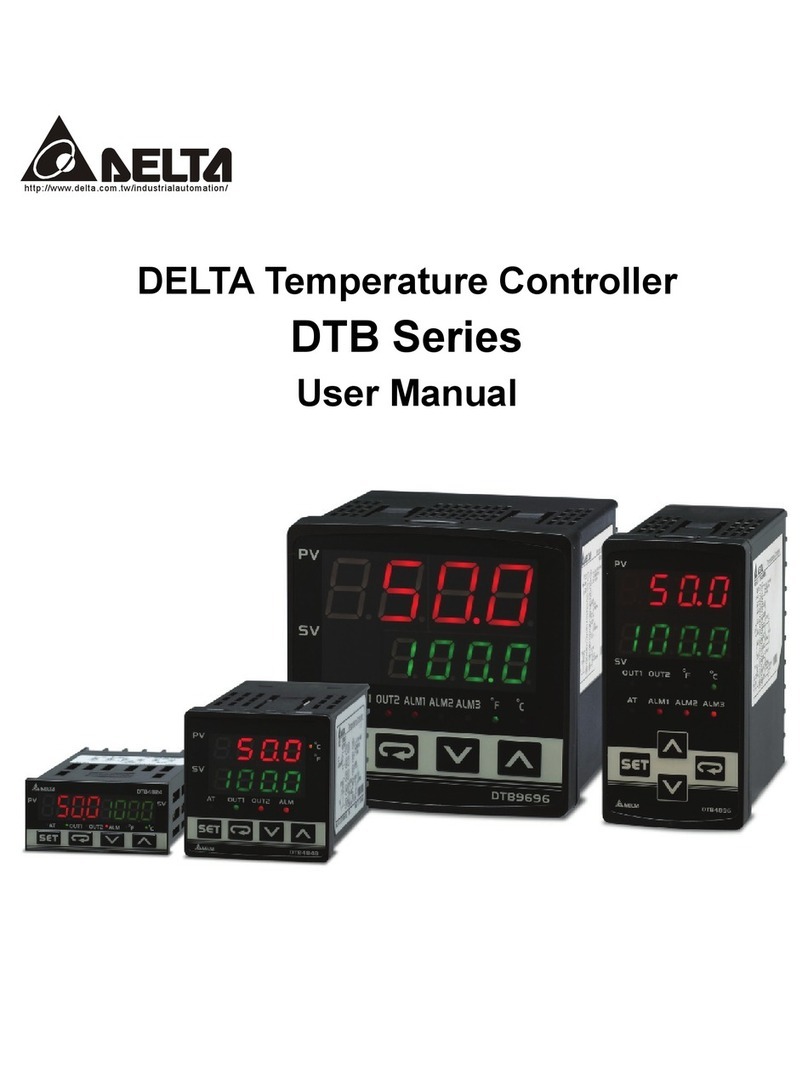
Delta
Delta DTB4824 User manual

Delta
Delta DTB4824 User manual
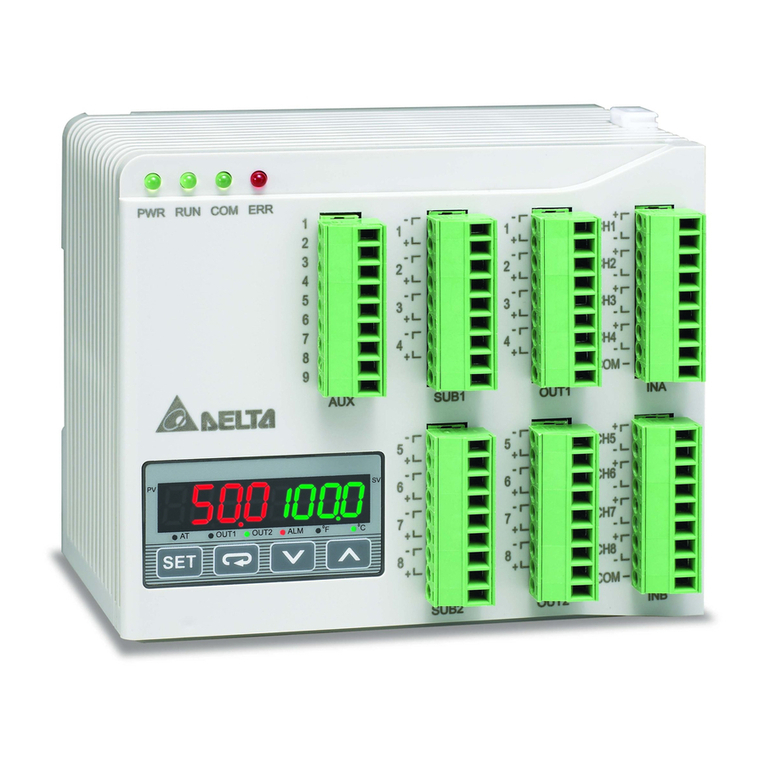
Delta
Delta DTE Series User manual
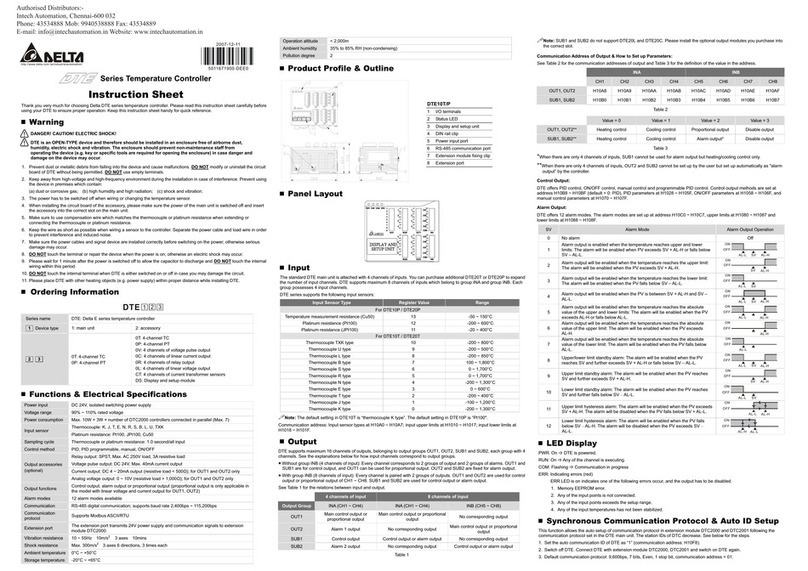
Delta
Delta DTE Series User manual
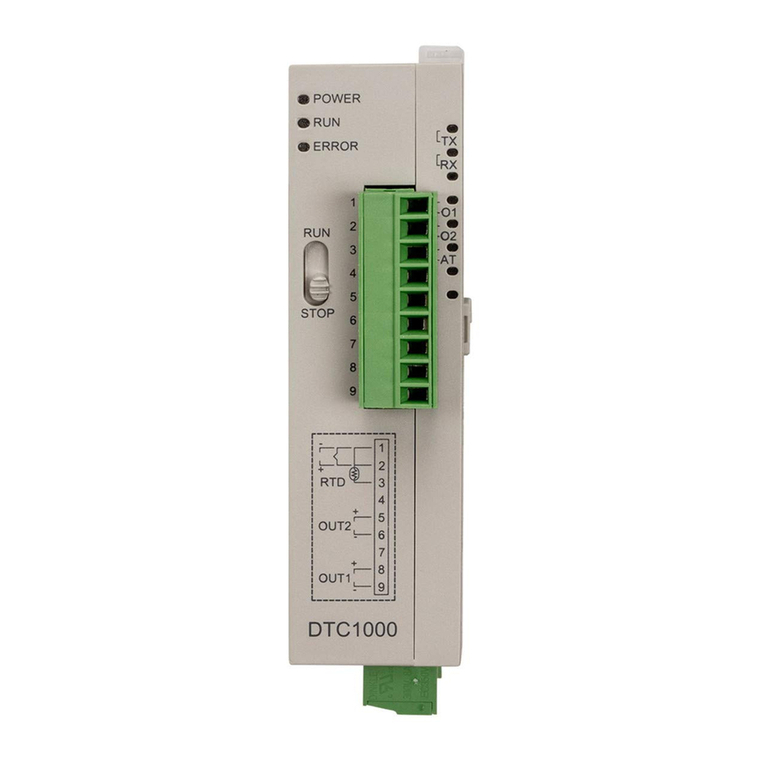
Delta
Delta DTC1000R User manual

Delta
Delta DTE Series User manual
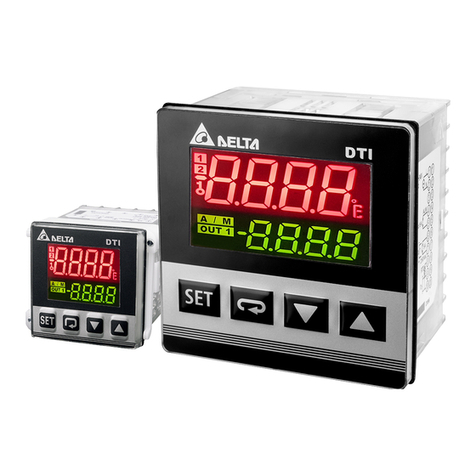
Delta
Delta DTI Series User manual
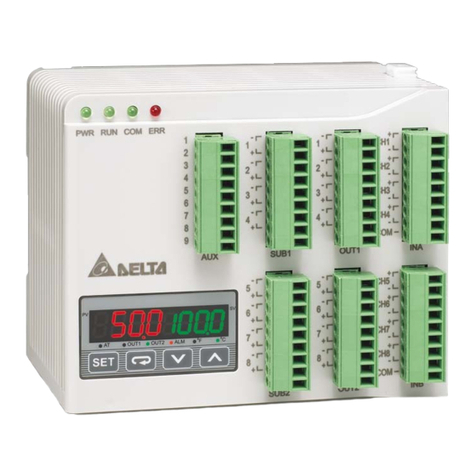
Delta
Delta DTE10T Series User manual
Popular Temperature Controllers manuals by other brands
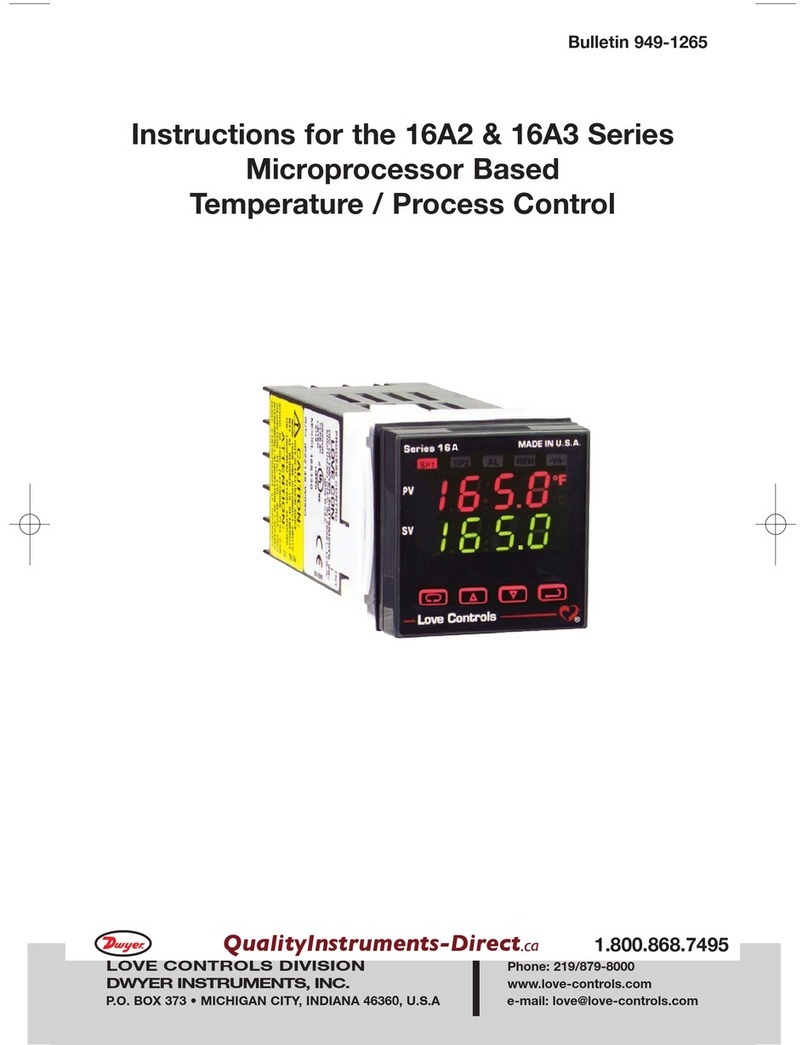
Dwyer Instruments
Dwyer Instruments 16A2 Series instructions
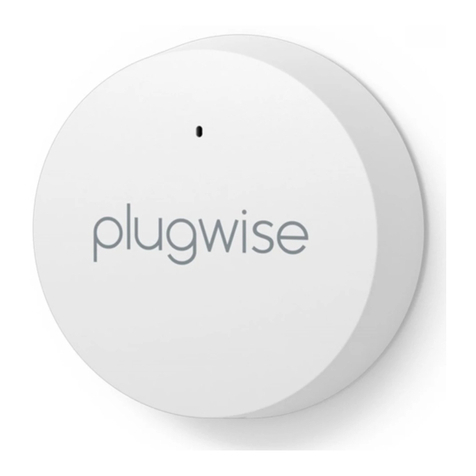
Plugwise
Plugwise Jip quick start
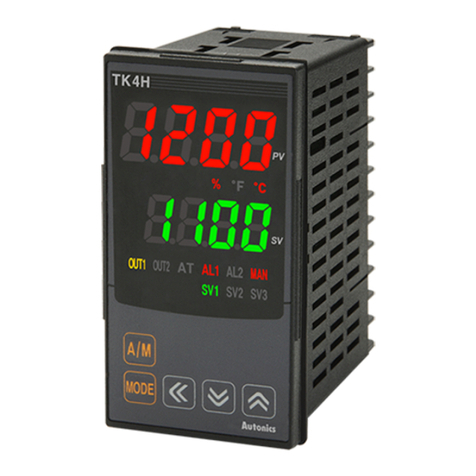
Autonics
Autonics TK Series User Manual for Communication
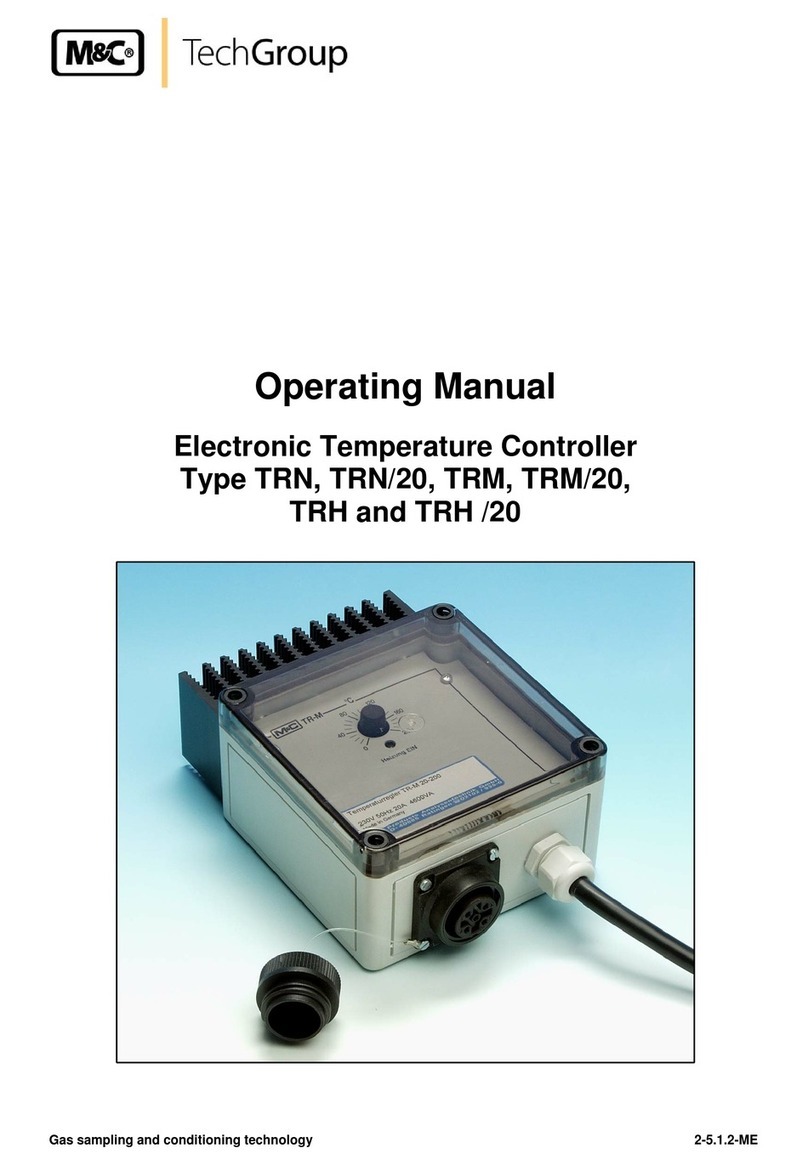
M&C
M&C TRN operating manual
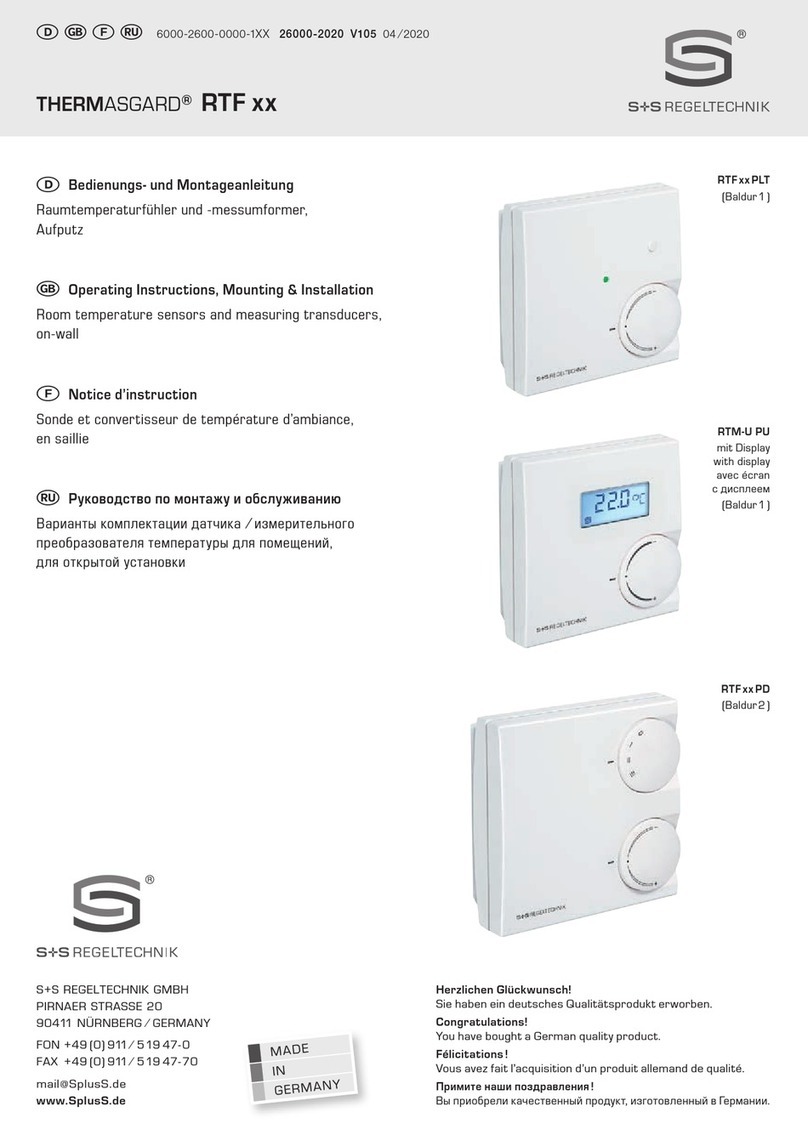
S+S Regeltechnik
S+S Regeltechnik THERMASGARD RTF Series Operating Instructions, Mounting & Installation
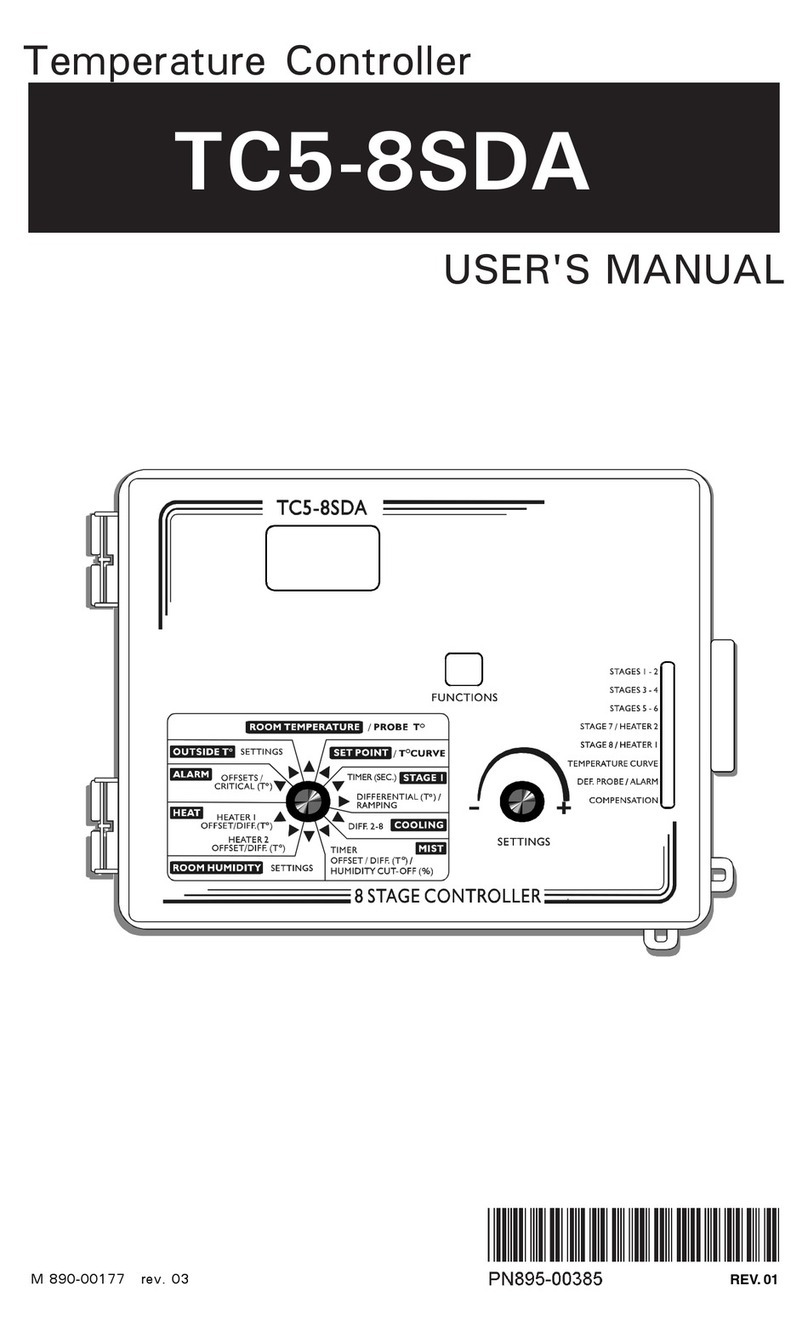
Thevco
Thevco TC5-8SDA user manual


